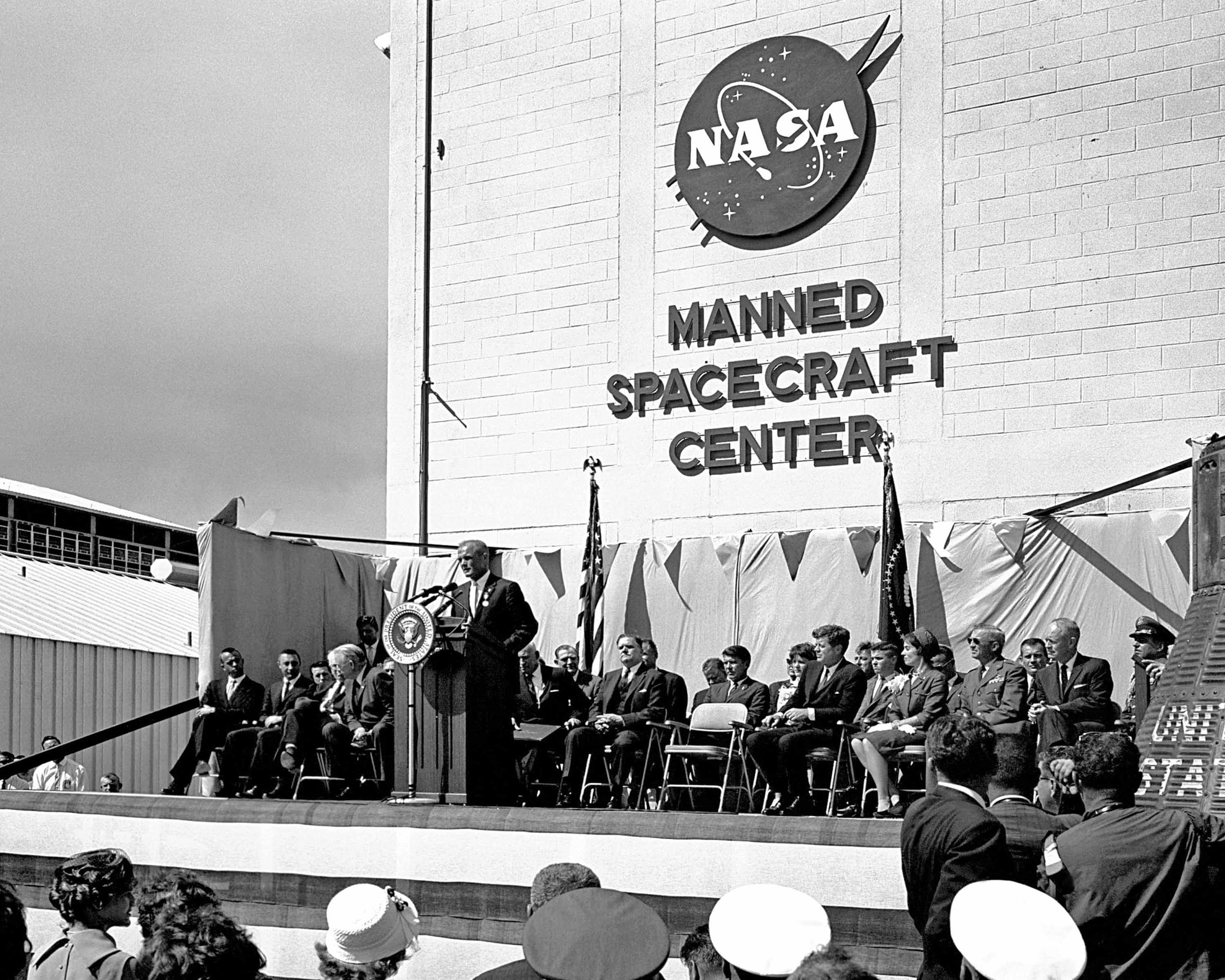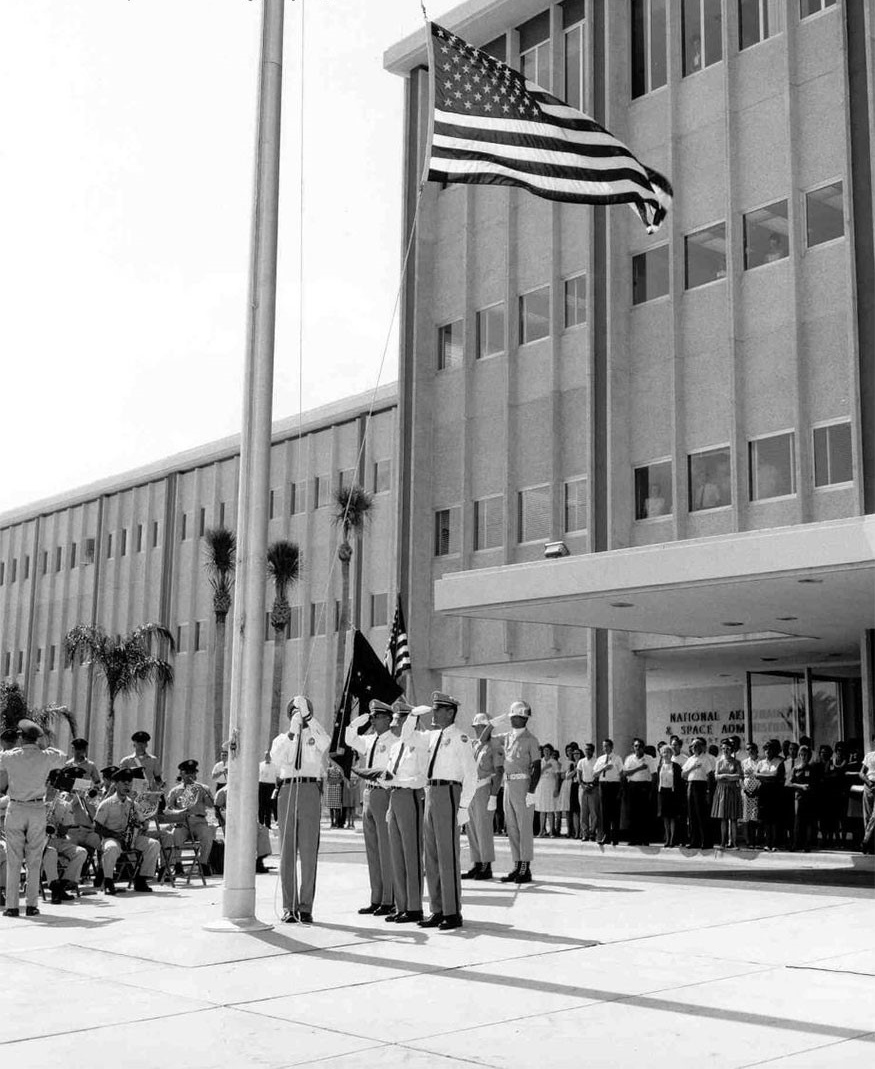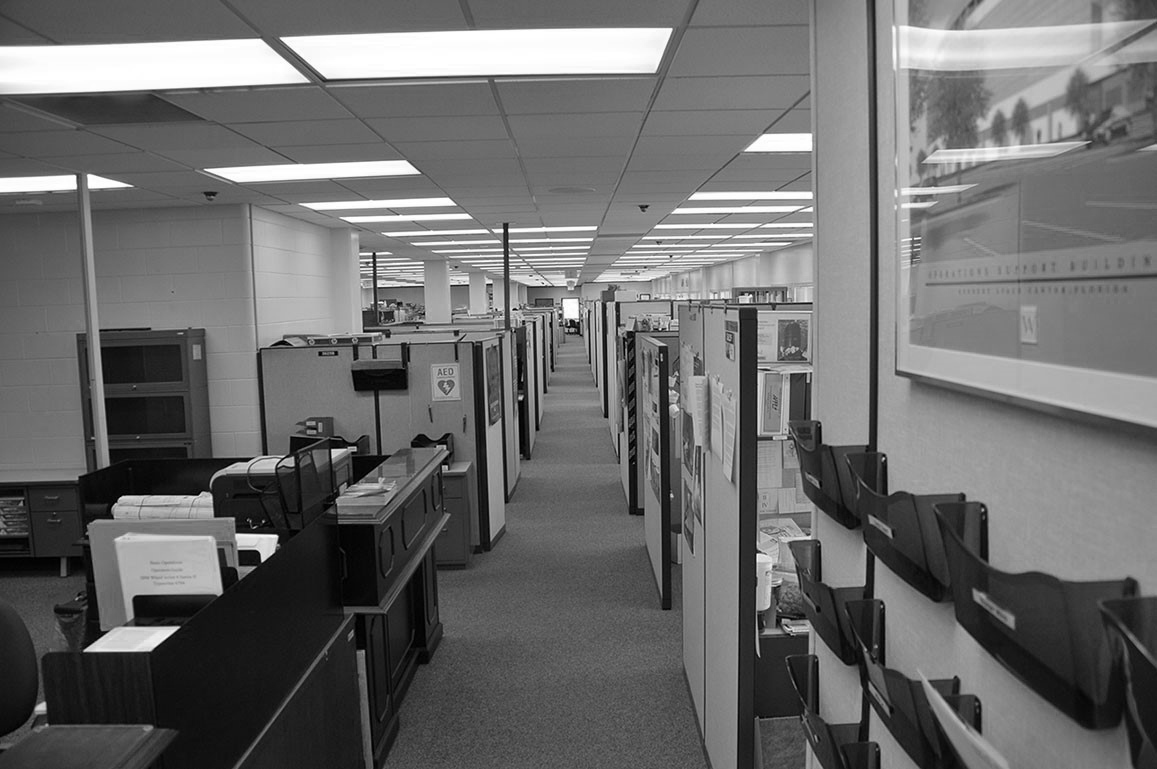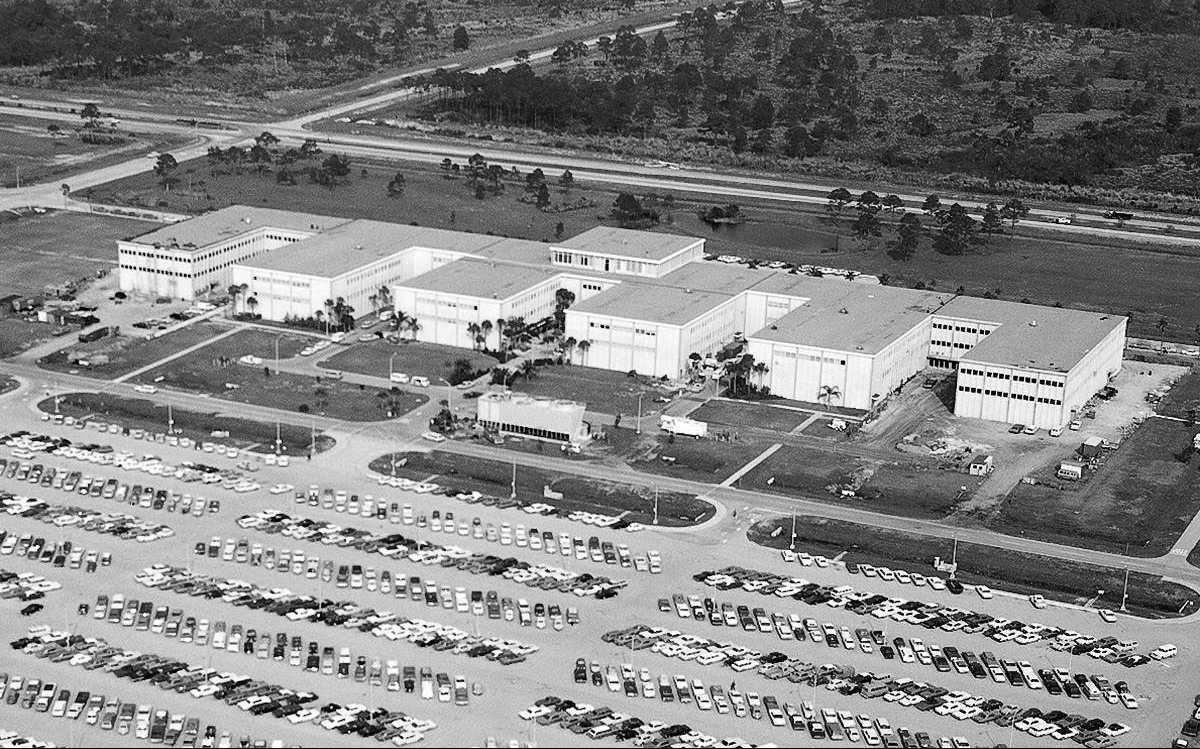In 1965, the National Aeronautics and Space Administration (NASA) constructed the John F. Kennedy Space Center (KSC) Headquarters Building. Located in the wetlands of Cape Canaveral, the United States relied on the remoteness of the wilderness for launching rockets along Florida’s Atlantic coast. Though the successes of the United States space programs also required strategic logistical coordination—including the architectural centralization of its administrative management—the KSC Headquarters existed in the shadows of NASA’s celebrated launchpads, control centers, and Vertical Assembly Building. Designed by architect and businessman Charles Luckman, these administrative facilities were praised for their modern forms’ alignments with the innovative spirit of the 1960s space program. More broadly however, the KSC and Cape Canaveral today sit as wastelands—a territory so shaped by its technical demands, many now obsolete, that it is unable to be used for any other purpose.1 Now scheduled for demolition, the KSC Headquarters finds itself unable to keep up with technological progress and unable to sustain its historical significance.
The Space Race charged a revolution in how cultural meta-narratives addressed place and technology. In 1965, an astonishing 2.66 percent of the US federal budget supported the National Aeronautics and Space Administration. But by 2014, funds for space exploration had depleted to only 0.5 percent, and private corporations have since filled the gap. And this gap is not only fiscal; the federally restricted landscape of Cape Canaveral has been left fractured by changes in technology and politics. NASA’s space complex, which once strategically coordinated rocket launches, research, and control centers, is now fractured as memorial, wasteland, and home to commercial space industries. Twenty years after being added to the National Register of Historic Places, the KSC Headquarters is scheduled for demolition in March 2019.2 This seemingly standard office building in the remote landscape played a key role in the projection of politics and of architectural modernity, but attempts at preservation have failed to identify or maintain its significance.
Examining the less-celebrated architectural elements of 1960s Cape Canaveral reveals a certain technological aesthetic of modernization that seems opposed to preservation.3 Changes in rocket technology required new launchpads, assembly facilities, and administrative restructuring. These place-based sites for science and technology were eventually dismissed, leaving behind wastelands—publicly inaccessible, economically abandoned, and environmentally ruined. The fact that “technology not only causes change, it is a response to change” was represented in the history of the space complex, as the military and economic modernization of NASA’s architectural forms had to constantly adapt to rocket development.4 The Kennedy Space Center not only enabled the reaching of the moon but also reshaped the public’s vision of politics and aligned NASA’s technological infrastructure with the interests of national power.

Cape Kennedy and the Projection of Politics
Securely isolated, Florida also became the government’s prime site for rocket and missile development. The site’s proximity to the equator more easily aligned rocket trajectories with the Earth’s orbit. Moreover, site selection for launching rockets after the first V2 launch in 1950 was not only geographically based but was also propelled by the existence of established infrastructure in the remote wilderness. In an Air Force report from March 1, 1954, it had been argued that Florida’s missile sites already included “an assembly hangar, a launching station, central and down-range instrumentation, facilities for data reduction, and other first-test engineering functions,” making it a reasonable geographic and economic decision.5 Once established in 1958, NASA followed this same logic when deciding on its site just across the Banana River from the Cape Canaveral Air Force Station.
Beyond the highly celebrated Vehicle Assembly Building and launchpads, the John F. Kennedy Space Center’s “Industrial Area” is comprised of over 150 buildings. One of the first constructed in this area was the KSC Headquarters, designed by Charles Luckman.6 As part of the larger launch complex, the KSC Headquarters and associated assembly of centralized facilities are not anonymous shells. Located five miles from the famous Apollo launchpads 39A and 39B, the KSC Industrial Area was the embodiment of the Cold War fear of nuclear conflict.7 The possibility of atomic bombing would have seemingly led to the decentralization and dispersal of military facilities.8 But here the architecture of Charles Luckman (typically office buildings in dense urban cores, such as New York and Boston), NASA’s remote office facilities, were counterintuitively centrally located within the wilderness of this highly operational landscape. Planning decisions for the Industrial Area were not driven by demands for decentralization but instead by the need to modernize and organize people and systems and by the equally important need to project the image of an efficient bureaucracy doing those things.
On November 28, 1963, six days after John F. Kennedy’s assassination, President Lyndon B. Johnson renamed the space complex Cape Kennedy.9 At first, office and operation facilities at the Kennedy Space Center didn’t seem to reflect this overt appearance of politics—based largely on the fact that the historical image of NASA had been associated with science and technology. But the KSC Headquarters Building soon became a background for political conquest. The blurring of military missiles with the burgeoning civilian space administration had been a strategy since Kennedy’s predecessor.10 Eisenhower was not interested in space exploration, but neither was Kennedy. In fact, President Kennedy used the space program for political maneuvering to distort international attention on national security. Even though it was Eisenhower who established NASA, in the end, it is Kennedy who is praised for space exploration. President Johnson’s dedication of “Cape Kennedy” helped secure Kennedy’s political legacy, and image, to the early NASA space programs. Just as President Kennedy became associated with national progress and aspirations for reaching the moon, NASA’s modern architectural forms in the remote wilderness were an attempt to manufacture a kind of front—similar to cultural historian Martin Jay’s criticism of how landscape design links “the human desire to mold the environment for aesthetic purposes with the domination of nature,” in this case producing a national image akin to an “artificial garden of imperial aggrandizement.”11

Charles Luckman and the Office Landscape
In its technologically infused patriotism, KSC epitomized America’s image of modernity. This led to businessman and architect Charles Luckman’s interest and eventually his involvement in the design and planning of NASA’s new spaceport complex. For Luckman, “the project that evoked my deepest emotional involvement as an architect and concerned citizen was the race to the moon, launched in May 1961, when President John F. Kennedy stirred the nation…”12 The culture of architectural modernism spreading out from American cities such as New York and Chicago was mirrored in the production of the space complex. For economist John Kenneth Galbraith, this transition of the bureaucracy’s administrative apparatus required a “technostructure”—the administrative body that contains the power to control its economic goals—enabling the technical landscape to become fully operational.13 This corresponded with Luckman’s philosophy of architecture, and of business in general.
The John F. Kennedy Space Center Headquarters Building was completed and operational by 1965. Known as “M6-399,” the massive facility housed two primary institutional arms—government offices (NASA) and the defense aerospace (United States military)—supported by 319,000 square feet to accommodate 2,031 employees. By 1968, an additional 120,000 square feet were added for 1,100 more people.14 The building is held up by reinforced concrete frames and enclosed by masonry walls. Vertical shallow fins on the façade mimicked the glass and steelwork of Mies van der Rohe in Chicago, an architect Luckman admired greatly. In line with Luckman’s business ethos, by the 1960s, companies in the United States were becoming more interested in reorganizing the office interior. In 1969, the Business Press published new ways to optimize the workplace, including a recommendation for efficient “office landscaping” that “embodies systems analysis, human factors and an intimate understanding of environmental control.”15 The adoption of what became known as the Burolandschaft model—removing constructed partitions from interior offices, encouraging freedom and autonomy— supposedly produced a more liberated workplace environment. However, this flexibility was not intended to increase human independence but rather was geared toward “achieving an optimum of order in the office.”16
The KSC Headquarters Building is located in a grid laid across 1,700 acres of Florida wetlands. The original building design anticipated future growth with plans for modular, incremental construction, defined by U- and L-shaped masses. The first U-shaped structure was completed in 1964, followed by the second phase in 1965 with two L-shaped wings on either side. By 1968, the third phase had added two more L-shaped wings. While the design anticipated change, the shell of the total of 439,000 square feet has since remained the same. The flexible interior is partly reminiscent of clear span shell structures used for hangar facilities to horizontally assemble rockets in the 1950s and partly a characteristic of “office landscaping.” These architecturally articulated slippages were key not only to the building’s public image but also to its functionality.
If the technological rigging of launch service towers and rocket smoke trails streaking across the Banana River are thought to be most iconic images of the Kennedy Space Center, then what of this austere finely tuned KSC Headquarters? Do these modern architectural objects in the remote Florida wasteland obscure the politics of the American space program? Charles Luckman was criticized heavily for his neglect of preservation when designing Madison Square Garden, a building considered to accrue economic gain but with an aesthetic loss.17 Its precursor, Penn Station, constructed in 1910, was considered to be the “finest landmark” in bustling New York City. But by 1963, the historic railroad station was demolished to make way for Luckman’s new Madison Square Garden multipurpose complex.18 Forty years later, in an obituary, Luckman was “remembered less for the buildings he designed than for inadvertently spurring architectural preservation to become a major national movement.”19 In 1999, the same year as his death, a strange reversal occurred: the KSC Headquarters Building was added to the National Register of Historic Places—marking its architectural and historical period of significance from 1965 to 1975.
Curiously, in the Historic American Buildings Survey (HABS) report, the architect/builder is listed as “unknown,” with no mention of Charles Luckman. And the KSC Headquarters is now scheduled for demolition. Rather than being recognized as a historically significant landmark capable of adaptation in the face of technological change, the building has been folded into Cape Canaveral’s longer, ongoing history of becoming a technical wasteland. It’s difficult to know if the report’s lack of association with Luckman is a simple clerical error or a political decision.

Wasteland, Wilderness, and Preservation
How is this impending wasteland to be understood in the context of NASA’s technological “success”? Cape Canaveral and KSC relied on the remote wilderness for security and safety. Initially, wilderness and wasteland may appear dichotomous. Indeed, the historian of science Peter Galison proposed in an interview that the idea of the forbidden wilderness and depleted territories like a nuclear wasteland might not be as different as one would imagine.20 In fact, Galison proposes that “once you think about wilderness as land too pure for more than an occasional visit, it becomes easier to think about the inverse; land that is too polluted for human use.”21 Although he predominantly spoke of “zones of exclusion” due to radioactive material such as the Nevada Test Site, the federally restricted sites at the KSC operated similarly. Wilderness here became a political territory—a wasteland of past technological progress.
In the 1960s, during the Johnson administration, American wilderness was at risk. With unparalleled political prowess, Lady Bird Johnson helped to “improve the appearance and quality” of the nation with her campaign for the beautification of the United States.22 As she once stated, “wherever I have gone in America, the wild beauties of nature spoke of the region,” and she suggested the country should begin “making that beauty available more broadly, in an organized way.”23 But available for whom, and organized to what ends? The Highway Beautification Act of 1965 (the same year the KSC Headquarters was being constructed) claimed that the country was challenged by the “changing face of the landscape, the junkyards of abandoned automobiles, the billboards, and the commercialization of the roadside.”24 But along with her “landscape management plans,” to organize “natural beauty” seemed counterintuitive. Reviewing God’s Own Junkyard by Peter Blake, J. B. Jackson critically proclaims that landscape preservationists are unable “to design in terms of changing patterns of use.”25 For Jackson, landscape must include the “economic and technological changes…transcending the concerns of daily existence.”26 KSC is the epitome of Jackson’s claims. The progress of rocket launchpads produced a technological aesthetic uninterested in preserving the American wilderness.
And yet, surrounded by Merritt Island National Wildlife Refuge—a highly preserved estuary considered to be one of the last “natural” beaches on the Florida coast—the paradox of the highly secured and remote Cape Canaveral Air Force Station (and subsequently the Kennedy Space Center) is precisely its “protection” of the wilderness. If landscape is indeed the “reflection of society,” then at KSC the preservationist’s goals are reversed, attempting to secure the building’s heritage on record but failing to understand its technical significance.
Wasteland may even appear oppositional to preservation.27 Wasteland, on one hand, is a condition of vast remoteness or of inherent natural complexity that does not allow for human occupation. On the other is an outcome of damage, rendering the site unsafe for occupation. Therefore, the wasteland “leaves no place ‘over there’ that is untouched by human presence, but posits all places, all categories are interconnected: the domesticated and the wild, the urban and the rural, the local and the global.”28 How, then, might a wasteland such as NASA’s KSC be best preserved in its demolition?
The same year Luckman died and the KSC Headquarters was registered as a Historical Building, Mark Wigley submitted that “technology is expendable, but technology raised to the level of art is permanent…a sense of the timeless is securely located within the flux of the present.”29 President Kennedy’s 1961 charge for a lunar landing by the end of the decade required the design of massive, centralized facilities. The attendant assembly of administrative buildings and their flexible interiors was an indication of architecture as subject and limit. The argument for construction was not about the protection of natural wildlife but about political positioning for a nation in transition. And yet, the active wasteland it has left behind preserves as much as it sought to shift.
Currently under construction immediately adjacent to the Luckman building, the new headquarters is less than half the size of the original facility, accommodating about 500 employees with 200,000 square feet of office space.30 Designed by HuntonBrady Architects, the new building will have “an accent color scheme representing a planet in the solar system” and will “embody the optimistic spirit of NASA and KSC.”31
The memorialized infrastructures at Cape Canaveral are forgotten histories, iconic forms of economic prosperity during the height of Cold War conflict. After various delays in the process, the old four-story building is slated for complete demolition this spring—a strange tension with its historical registration and Luckman’s modern design anticipating adaptability. The old KSC Headquarters Building is not an artifact recognized for its technological prowess, or even for its innovation in office landscape, but for a past desire to associate Kennedy’s politics with NASA’s historical successes. With the building’s demolition, KSC Headquarters now plays a much broader role in defining wasteland, as an indication of national interests in urgency and flexibility over permanence, and of historical interests in modernity as politics.

-
Julie Kruse and Peter Galison, “Waste-wilderness: A Conversation with Peter L. Galison,” Friends of the Pleistocene, March 31, 2011, link. ↩
-
NASA, “NASA Awards Construction Contract at Kennedy Space Center,” NASA news release, July 17, 2014. See also A. Heiney, “Teams Prepare to Lay Foundation of Kennedy’s Future,” NASA Kennedy News, updated August 7, 2017, link. For more contemporary text on the abandonment of NASA facilities, see J. Teicher, “NASA’s Crumbling Launch Sites Are Like America’s Greek Ruins,” Slate, March 18, 2016, link. ↩
-
Mark Wigley, “The Architectural Cult of Synchronization,” Journal of Architecture, vol. 4, no. 4 (1999): 409–435. Wigley proposes an intriguing perspective on how one can view the relationship between preservation and modernization, suggesting that “historical preservation is inseparable from modernization.” ↩
-
John Kenneth Galbraith, The New Industrial State (London: Hamish Hamilton, 1967), 18–19. ↩
-
J. E. Lipp and R. M. Salter, Project Rand: Project Feed Back Summary Report, vol. 1, March 1, 1954 (declassified November 14, 1995). According to a previously classified Air Force report, four criteria were considered for site selection: there should be no dependence on foreign sites or on waterborne communication facilities; ZI (zone of interior) operation would be desirable for reasons of security, weather, and morale; short lines of communication with the intelligence center would be desirable; and location far to the north would tend to maximize the potential space-to-ground communication time per day (and thus to minimize the number of sites and the onboard storage capacity required). Based on these criteria, the report suggests Alaska was the best site for rocket launches, not Florida. ↩
-
Charles Luckman, Twice in a Lifetime: From Soaps to Skyscrapers (New York: W. W. Norton, 1988). Luckman’s commitment and perseverance in his pursuit of government contracts at an early age under the Truman administration paid off, and quickly Charles Luckman, with his architecture partner William Pereira, received federal commissions for the design of government facilities in the Eisenhower era. ↩
-
Charles Benson and William Faherty, Moonport: A History of Apollo Launch Facilities and Operations, The NASA History Series (Washington, DC: NASA, 1978), 87–107. ↩
-
Peter Galison, “War against the Center,” in Architecture and the Sciences: Exchanging Metaphors, ed. A. Picon and A. Ponte (Princeton, NJ: Princeton Architectural Press, 2003). ↩
-
“Canaveral Now Cape Kennedy: Johnson Renames Site as Memorial,” Daily News, November 29, 1963. ↩
-
Mark Shanahan, Eisenhower at the Dawn of the Space Age: Sputnik, Rockets, and Helping Hands (Lanham, MD: Lexington Books, 2016). Historian Mark Shanahan provocatively claims that Eisenhower’s role in the creation of the infrastructure for the Unites States’ space activities is underplayed. He argues that much of the “groundwork” was achieved well before Kennedy’s presidency, and certainly before Kennedy’s famous public address announcing the mission to go to the moon. Shanahan claims that this historical canon had not been challenged because there was not a strong connection between the NASA space program and early reconnaissance satellites and military missiles. ↩
-
Martin Jay, “No State of Grace: Violence in the Garden,” in Essays from the Edge: Parerga and Paralipomena (Charlottesville, VA: University of Virginia Press, 2011), 64–76. For Jay, the garden should be an extension of the countryside, not a formalized extension of an architectural order. Therefore, landscaping has been naturalized and “gardens are precisely the sites in which force and human violence are in tense constellation with collective power.” ↩
-
Luckman, Twice in a Lifetime, 391. ↩
-
Galbraith, Industrial State. Galbraith argues that “it is reasonably certain that a man can be landed on the moon within the next five years,” based on modernization’s “measure of certainty,” 19. ↩
-
Historic American Buildings Survey, “Cape Canaveral Air Force Station, Launch Complex 39, Headquarters Building,” HABS No. FL-581-A (Atlanta, GA: National Park Service, 1999). As noted in the HABS report, “the Headquarters Building displays the lack of ornament, effect of volume, flat roof, ribbon windows, skeleton construction, and horizontally which are hallmarks of the International Style.” ↩
-
Carroll Cihlar, “Landscaping: An Environmental System,” in Office Landscaping (Elmhurst, IL: The Business Press, 1969), 13–15; Hans J. Lorenzen, “The Economic Reasons behind Landscaping,” in Office Landscaping, 38–41. ↩
-
Cihlar, “Landscaping,” 13–15. ↩
-
Susanne Broyles, “Penn Station and the Rise of Historic Preservation,” Museum of the City of New York, New York Stories, May 8, 2012, link. ↩
-
Ada Louise Huxtable, “Farewell to Penn Station,” the New York Times, October 30, 1963, 38. Huxtable called it a “monumental act of vandalism,” adding that “we will probably be judged not by the monuments we build but by those we have destroyed.” See also “New Madison Sq. Garden to Rise Atop Penn Station,” the New York Times, July 25, 1961, 1. ↩
-
Herbert Muschamp, “Charles Luckman, Architect Who Designed Penn Station’s Replacement, Dies at 89,” the New York Times, January 28, 1999.
The Headquarters Building is representative of the Federal Government’s use of the International Style. Although it has undergone interior renovations with the advent of new technology, it continues to maintain its integrity of design, materials, workmanship, feeling, setting, location, and association as an administrative center of the Apollo Program.[^20]
-
Kruse and Galison, “Waste-wilderness.” If both wilderness and wasteland can be seen as uninhabitable sites for human occupation, then these wildernesses and wastelands “form something of a different topological order.” ↩
-
Kruse and Galison, “Waste-wilderness.” ↩
-
Lewis L. Gould, “First Lady as Catalyst: Lady Bird Johnson and Highway Beautification in the 1960s,” Environmental Review 10 (1986): 76–92. ↩
-
Lady Bird Johnson, “On Preserving Wildness,” Southwest Review 69 (1984): 194–200. ↩
-
Gould, “First Lady as Catalyst,” 76–92. ↩
-
J. B. Jackson, “Limited Access: The American Landscape Seen in Passing,” Landscape, vol. 14, no. 1 (Autumn 1964): 18–23. ↩
-
Jackson, “Limited Access,” 23. ↩
-
Kruse and Galison, “Waste-wilderness.” ↩
-
Vittoria Di Palma, Wasteland: A History (New Haven, CT: Yale University Press, 2014), 244. ↩
-
Wigley, “Architectural Cult,” 39. ↩
-
HuntonBrady Architects, “How Architecture Will Launch NASA into Next Century,” February 21, 2017, link. ↩
-
HuntonBrady Architects, “How Architecture Will Launch NASA into Next Century.” ↩
Jeffrey S. Nesbit is an architect, urbanist, and doctoral candidate at Harvard University Graduate School of Design. Currently, his dissertation explores spaceport infrastructure through the extraterrestrial, a space situated between technological imaginary and limits of rationality. Nesbit is co-editor of the book Chasing the City (Routledge, 2018) and is editor of the forthcoming New Geographies 11: Extraterrestrial (Actar, 2019).

